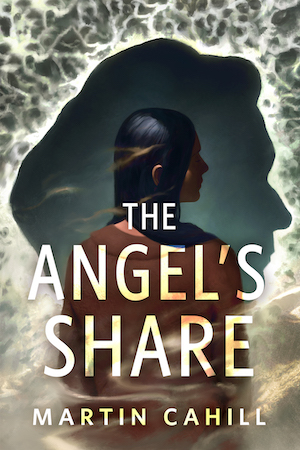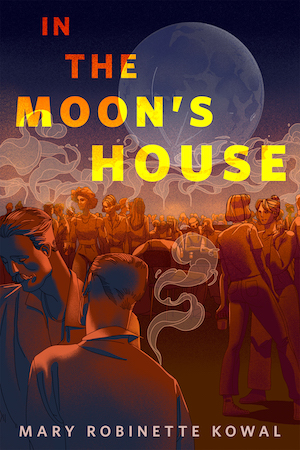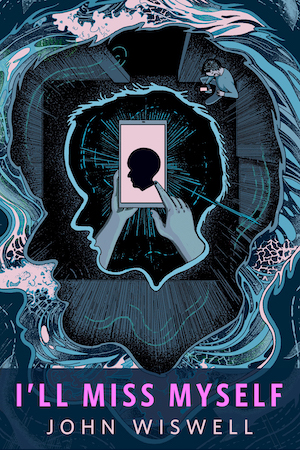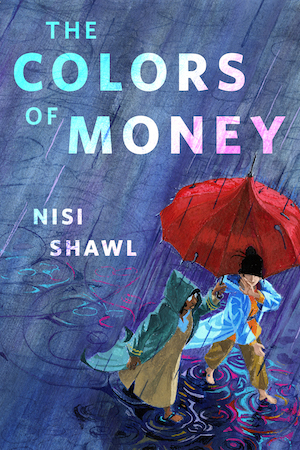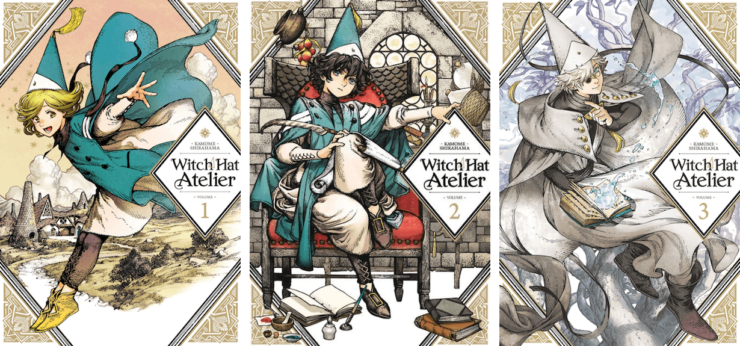Witch Hat Atelier, Kamome Shirahama’s secondary-universe fantasy manga series, stands out among recent delightful manga discoveries. Two volumes in, it is a delight along pretty much every James-specific axis. It’s an exemplary example of a genre I call hard fantasy. But before I define hard fantasy, a bit about the manga.
Witch Hat Atelier is about magic, fulfilling one’s potential despite a society that forbids it, embracing the wonders of the universe and, uh, accidentally killing one’s mother.
Authorized witches have chosen to protect magic from enthusiastic dabblers through obfuscation and obscurity. They claim only the chosen few can work magic (not true). They then take care to ensure that no non-witch (no “unknowings”) can see magic being worked, as that might give the game away.
Coco was enraptured by magic as a child and greatly disappointed to learn that she cannot study it, as she comes from an unknowing bloodline. And then…a passing witch named Qifrey comes to make a small magical repair and asks Coco to stand guard to prevent curious children from peeking at him. Coco spies on Qifrey herself. This is how she learns that magic is done by drawing runes.
This insight alone would not be enough to work magic. But Coco is given a grimoire, a pen, and special ink by a Brimhat (the Brimhats are witches who object to the rules against teaching magic; they wear identity-concealing brimmed hats). Those tools and her glimpse of Qifrey at work are enough to set her on a course of magical self-education.
Trial and error is a bad way to learn magic. A few experiments down the road, a transformation spells spirals out of control. Qifrey is able to halt the spell, but not before Coco’s beloved mother is transformed into a statue.
Coco has learned the hard way that there are good reasons for keeping magic a closely held monopoly. In earlier times, widespread use of magic had created many such catastrophes. To put this in modern terms, it was as through everyone had their own personal nuclear arsenal. Having barely survived an era of open-to-all magic, the witches took steps to ensure that this would never happen again.
(It was, of course, purely coincidental that limiting magic to witch families gave them a massive amount of power.)
From time to time an unknowing learns too much about magic. There’s a cure for this: memory erasure. Coco’s dreadful experience of accidental matricide is just the kind of thing that demonstrates that limiting magic is necessary. By rights, after stopping the runaway spell Qifrey should have erased all of Coco’s memories of magic.
But if Qifrey were to do so, he wouldn’t know WHO gave Coco the grimoire, pen, and ink. That Brimhat is dangerous; that Brimhat must be stopped. So Qifrey lets Coco keep her memories, while at the same time stopping further experimentation by enrolling her in his magic school. If she’s going to do it, she must learn to do it right.
Pro: Coco gets to learn about magic in the company of like-minded students. Con: there are a lot of cons, not least of which is that not all of her fellow students think that an unknowing has any place in Qifrey’s atelier. The biggest con may be that the Witches Council will find out what Qifrey is doing and come down hard on him and on Coco.
Oh, and there’s a dangerous Brimhat out there who may decide that Coco’s memories should be expunged. Or even that Coco should be expunged entirely.
***
As regular readers know, I love well-done worldbuilding in SF and fantasy. I give this manga high marks for plausible magic. In all too many fantasies, magic is arbitrary. Plot needs determine what magic can do; there’s no unifying theory of magic (or if there is, the author isn’t telling us about it). Witch Hat Atelier, in contrast, has a well-worked-out theory. There are a few straightforward rules that shape what magic can do and how it can be done. The author has thought deeply about the consequences of those rules and built her plot around them. This approach is what I would call hard fantasy.
For example, magic runes only begin to work once the pattern is completed. There are a number of rune-inscribed magic items that come in pairs, each of which is actuated by half a rune. Until the halves are joined, nothing happens. Touch the pair of flying shoes together and soar aloft. Elegant and plausible.
Not everyone shares my taste for what Hal Clement called “the game.” But even if you don’t like worldbuilding, you may well like this manga for the sumptuous art. It’s evocative and draws the reader into the story.
Or you may like the manga for the cast of characters. Coco is a sympathetic character. Her slowly growing friendship with schoolmates Agott, Tetia, and Richeh is deftly told. The gang have adventures, to which each student brings their own strengths and weaknesses.
Or, you may just enjoy thrilling adventures and unforeseen plot twists.
North American publisher Kodansha USA has translated and published no less than nine Witch Hat Atelier tankōbon since April 9, 2019. The series is still being published in Japan, so if you get hooked you can look forward to even more tankōbon (with delays, unless you read Japanese). Two thumbs up.
So…what other fantasies or fantasy series are hard fantasy? That’s a matter for another essay….
In the words of fanfiction author Musty181, prolific book reviewer and perennial Darwin Award nominee James Davis Nicoll “looks like a default mii with glasses.” His work has appeared in Publishers Weekly and Romantic Times as well as on his own websites, James Nicoll Reviews (where he is assisted by editor Karen Lofstrom and web person Adrienne L. Travis) and the 2021 and 2022 Aurora Award finalist Young People Read Old SFF (where he is assisted by web person Adrienne L. Travis). He is a four-time finalist for the Best Fan Writer Hugo Award, and is surprisingly flammable.


